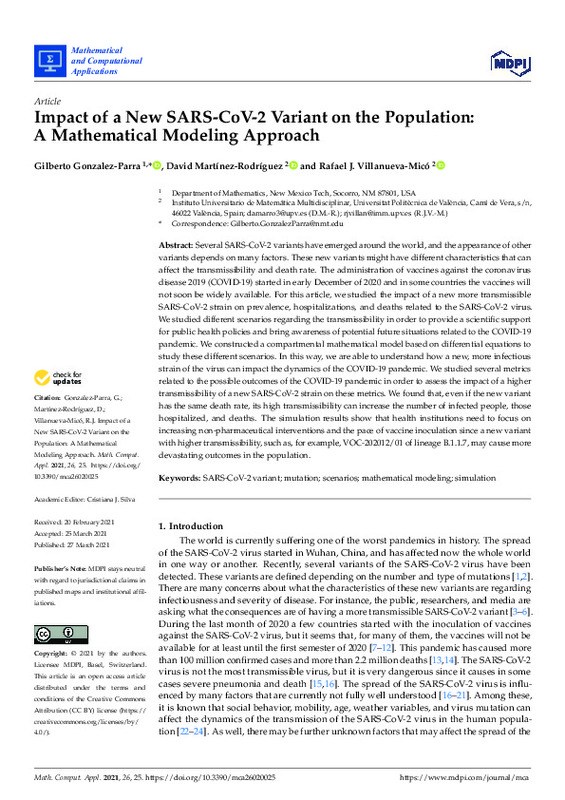JavaScript is disabled for your browser. Some features of this site may not work without it.
Buscar en RiuNet
Listar
Mi cuenta
Estadísticas
Ayuda RiuNet
Admin. UPV
Impact of a New SARS-CoV-2 Variant on the Population: A Mathematical Modeling Approach
Mostrar el registro sencillo del ítem
Ficheros en el ítem
| dc.contributor.author | González Parra, Gilberto
|
es_ES |
| dc.contributor.author | Martínez-Rodríguez, David
|
es_ES |
| dc.contributor.author | Villanueva Micó, Rafael Jacinto
|
es_ES |
| dc.date.accessioned | 2022-02-21T19:03:42Z | |
| dc.date.available | 2022-02-21T19:03:42Z | |
| dc.date.issued | 2021-03-27 | es_ES |
| dc.identifier.uri | http://hdl.handle.net/10251/181029 | |
| dc.description.abstract | [EN] Several SARS-CoV-2 variants have emerged around the world, and the appearance of other variants depends on many factors. These new variants might have different characteristics that can affect the transmissibility and death rate. The administration of vaccines against the coronavirus disease 2019 (COVID-19) started in early December of 2020 and in some countries the vaccines will not soon be widely available. For this article, we studied the impact of a new more transmissible SARS-CoV-2 strain on prevalence, hospitalizations, and deaths related to the SARS-CoV-2 virus. We studied different scenarios regarding the transmissibility in order to provide a scientific support for public health policies and bring awareness of potential future situations related to the COVID-19 pandemic. We constructed a compartmental mathematical model based on differential equations to study these different scenarios. In this way, we are able to understand how a new, more infectious strain of the virus can impact the dynamics of the COVID-19 pandemic. We studied several metrics related to the possible outcomes of the COVID-19 pandemic in order to assess the impact of a higher transmissibility of a new SARS-CoV-2 strain on these metrics. We found that, even if the new variant has the same death rate, its high transmissibility can increase the number of infected people, those hospitalized, and deaths. The simulation results show that health institutions need to focus on increasing non-pharmaceutical interventions and the pace of vaccine inoculation since a new variant with higher transmissibility, such as, for example, VOC-202012/01 of lineage B.1.1.7, may cause more devastating outcomes in the population. | es_ES |
| dc.description.sponsorship | Funding support from the National Institute of General Medical Sciences (P20GM103451) via NM-INBRE is gratefully acknowledged by the first author. | es_ES |
| dc.language | Inglés | es_ES |
| dc.publisher | MDPI AG | es_ES |
| dc.relation.ispartof | Mathematical and Computational Applications (Online) | es_ES |
| dc.rights | Reconocimiento (by) | es_ES |
| dc.subject | SARS-CoV-2 variant | es_ES |
| dc.subject | Mutation | es_ES |
| dc.subject | Scenarios | es_ES |
| dc.subject | Mathematical modeling | es_ES |
| dc.subject | Simulation | es_ES |
| dc.subject.classification | MATEMATICA APLICADA | es_ES |
| dc.title | Impact of a New SARS-CoV-2 Variant on the Population: A Mathematical Modeling Approach | es_ES |
| dc.type | Artículo | es_ES |
| dc.identifier.doi | 10.3390/mca26020025 | es_ES |
| dc.relation.projectID | info:eu-repo/grantAgreement/NIGMS//P20GM103451/ | es_ES |
| dc.rights.accessRights | Abierto | es_ES |
| dc.contributor.affiliation | Universitat Politècnica de València. Departamento de Matemática Aplicada - Departament de Matemàtica Aplicada | es_ES |
| dc.contributor.affiliation | Universitat Politècnica de València. Instituto Universitario de Matemática Multidisciplinar - Institut Universitari de Matemàtica Multidisciplinària | es_ES |
| dc.description.bibliographicCitation | González Parra, G.; Martínez-Rodríguez, D.; Villanueva Micó, RJ. (2021). Impact of a New SARS-CoV-2 Variant on the Population: A Mathematical Modeling Approach. Mathematical and Computational Applications (Online). 26(2):1-21. https://doi.org/10.3390/mca26020025 | es_ES |
| dc.description.accrualMethod | S | es_ES |
| dc.relation.publisherversion | https://doi.org/10.3390/mca26020025 | es_ES |
| dc.description.upvformatpinicio | 1 | es_ES |
| dc.description.upvformatpfin | 21 | es_ES |
| dc.type.version | info:eu-repo/semantics/publishedVersion | es_ES |
| dc.description.volume | 26 | es_ES |
| dc.description.issue | 2 | es_ES |
| dc.identifier.eissn | 2297-8747 | es_ES |
| dc.relation.pasarela | S\431626 | es_ES |
| dc.contributor.funder | National Institute of General Medical Sciences, EEUU | es_ES |








